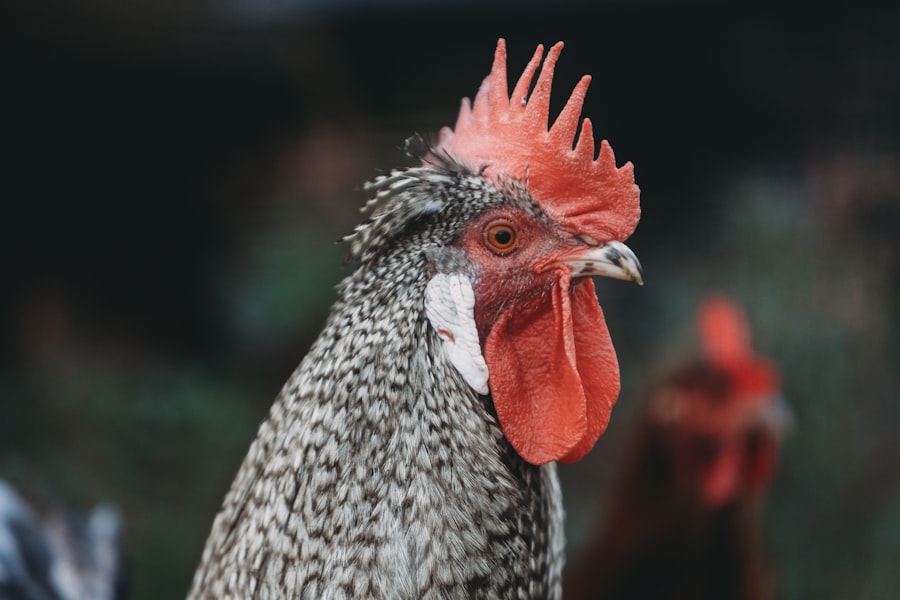Foxes are a common predator that pose a threat to backyard chickens. These cunning creatures are known for their ability to sneak into coops and snatch up unsuspecting birds. It is important for chicken owners to take precautions to protect their flock from these predators. By understanding the threat that foxes pose and implementing preventative measures, you can ensure the safety and well-being of your chickens.
Key Takeaways
- Foxes pose a serious threat to chickens and their safety should not be taken lightly.
- Signs of fox activity around your coop include paw prints, droppings, and missing chickens.
- Choosing the right coop design and reinforcing it with fox-proof fencing and netting can deter foxes from attacking.
- Motion-activated lights and alarms can scare off foxes, while natural deterrents and plant barriers can keep them away.
- Removing attractants from your property and educating your community about fox safety can also help prevent attacks.
Understanding the Threat of Foxes to Your Chickens
Foxes are natural predators of chickens and can cause significant damage to a flock if not properly managed. They are skilled hunters and have a keen sense of smell, hearing, and sight, making them highly efficient at locating and capturing prey. Foxes are known to be opportunistic feeders and will take advantage of any easy meal they come across.
One of the main reasons foxes pose a threat to chickens is their ability to dig and burrow. They can easily dig under fences or coop walls, gaining access to your flock. Additionally, foxes are known for their agility and ability to climb, so even if your coop is elevated or has a roof, they may still find a way in.
Identifying Signs of Fox Activity Around Your Coop
It is important to be aware of signs of fox activity around your coop in order to take appropriate action. Some common signs include tracks, droppings, and feathers scattered around the area. Fox tracks are typically small and oval-shaped with four toes and claw marks. Droppings may resemble those of a small dog but often contain fur or feathers.
Being aware of these signs can help you identify if there is a fox in the area and take necessary precautions to protect your flock. It is also important to note that foxes are most active during dawn and dusk, so keep an eye out during these times for any signs of activity.
Choosing the Right Coop Design to Deter Foxes
| Coop Design | Effectiveness in deterring foxes | Cost | Space required |
|---|---|---|---|
| Enclosed coop with wire mesh | High | Medium | Large |
| Coop with raised floor | Medium | Low | Medium |
| Coop with electric fencing | High | High | Small |
| Coop with predator-proof locks | Medium | Low | Small |
Choosing the right coop design is crucial in deterring foxes from accessing your chickens. A good coop design should have solid walls and a secure roof to prevent foxes from climbing or digging their way in. It is also important to ensure that there are no gaps or holes in the coop that a fox could squeeze through.
Consider using hardware cloth instead of chicken wire for the windows and vents of your coop, as foxes can easily chew through chicken wire. Additionally, reinforce the bottom of the coop with buried wire mesh to prevent foxes from digging underneath.
Reinforcing Your Coop with Fox-Proof Fencing and Netting
In addition to a secure coop design, it is important to reinforce your coop with fox-proof fencing and netting. This will create an extra layer of protection and prevent foxes from gaining access to your chickens.
When choosing materials for your fencing, opt for sturdy materials such as welded wire or chain link. Make sure the fencing is buried at least 12 inches into the ground to prevent foxes from digging underneath. Additionally, consider adding an electric fence or netting around the perimeter of your coop for added protection.
Using Motion-Activated Lights and Alarms to Scare Off Foxes

Motion-activated lights and alarms can be effective in scaring off foxes and preventing them from approaching your coop. These devices work by detecting movement and emitting a bright light or loud noise, which can startle and deter foxes.
When choosing motion-activated lights or alarms, opt for ones specifically designed for deterring wildlife. These devices are typically weatherproof and have adjustable sensitivity settings. Install them strategically around your coop, focusing on areas where foxes are most likely to approach.
Using Natural Deterrents to Keep Foxes Away from Your Coop
Natural deterrents can be used in conjunction with other preventative measures to keep foxes away from your coop. Predator urine, such as that from coyotes or wolves, can be effective in deterring foxes. You can purchase predator urine online or at hunting supply stores and apply it around the perimeter of your coop.
Plants with strong scents, such as lavender or rosemary, can also help deter foxes. Plant these around your coop to create a barrier that foxes are less likely to cross. Additionally, consider planting prickly bushes or thorny plants near the base of your coop to make it more difficult for foxes to approach.
Creating a Barrier of Plants and Shrubs to Protect Your Chickens
Creating a barrier of plants and shrubs around your coop can provide an additional layer of protection for your chickens. Choose plants that are dense and have thorns or prickly leaves to make it difficult for foxes to access your coop.
Some examples of plants that can be used as a barrier include holly bushes, barberry shrubs, and pyracantha. These plants not only provide protection but also add beauty to your chicken coop area.
Removing Attractants from Your Property to Reduce Fox Activity
To reduce fox activity around your property, it is important to remove any attractants that may be drawing them in. This includes removing any food sources, such as fallen fruit or bird feeders, that may be attracting small animals that foxes prey upon.
Additionally, make sure to secure any garbage cans or compost bins so that they are inaccessible to foxes. Remove any potential hiding spots, such as brush piles or woodpiles, where foxes may seek shelter.
Educating Your Neighbors and Community About Fox Safety
Educating your neighbors and community about fox safety is important in preventing conflicts between humans and wildlife. Many people may not be aware of the threat that foxes pose to backyard chickens and may inadvertently attract them by leaving out food or not properly securing their own coops.
Spread the word about the importance of taking precautions to protect chickens from foxes. Share information through community newsletters, social media groups, or local workshops. Encourage others to implement preventative measures and be mindful of their actions that may attract foxes.
Preparing for Worst-Case Scenarios: What to Do If a Fox Attacks Your Chickens
Despite your best efforts, there is always a chance that a fox may attack your chickens. It is important to be prepared for these worst-case scenarios and know what to do if it happens.
If a fox attacks your chickens, remove any injured birds from the coop and provide immediate medical attention. Clean wounds with an antiseptic solution and apply an antibiotic ointment. Keep the injured bird in a quiet and warm area while it recovers.
To prevent future attacks, reinforce your coop and implement additional deterrents. Consider installing motion-activated sprinklers or using guard animals, such as dogs or geese, to deter foxes from approaching your coop.
Protecting your backyard chickens from foxes requires a combination of preventative measures and proactive actions. By understanding the threat that foxes pose and implementing strategies such as choosing the right coop design, reinforcing with fencing and netting, using motion-activated lights and alarms, and utilizing natural deterrents, you can ensure the safety of your flock. Additionally, removing attractants from your property, educating your neighbors and community, and being prepared for worst-case scenarios will help minimize the risk of fox attacks. Take action today to protect your chickens from these cunning predators.
If you’re looking for ways to keep foxes away from your chickens, you might find this article on “Chicken Coop Door Size” helpful. It provides valuable information on the ideal size for chicken coop doors to prevent foxes from gaining access to your flock. Check it out here.
FAQs
What are foxes?
Foxes are small to medium-sized carnivorous mammals that belong to the Canidae family. They are known for their bushy tails and pointed ears.
Why do foxes attack chickens?
Foxes attack chickens because they are natural predators and chickens are easy prey. Foxes are attracted to the smell and sound of chickens, making them a target for attack.
What are the signs of a fox attack on chickens?
Signs of a fox attack on chickens include missing birds, feathers scattered around the coop or yard, and bite marks on the remaining chickens.
How can I keep foxes away from my chickens?
You can keep foxes away from your chickens by securing your coop and yard with sturdy fencing, using motion-activated lights and alarms, and keeping your chickens locked up at night.
What are some natural ways to deter foxes?
Some natural ways to deter foxes include using strong-smelling herbs like lavender and mint, planting prickly bushes around the coop, and using predator urine or hair around the perimeter of the yard.
What should I do if a fox attacks my chickens?
If a fox attacks your chickens, remove any injured birds and secure the coop and yard. Contact your local wildlife agency for assistance in dealing with the fox.
Meet Walter, the feathered-friend fanatic of Florida! Nestled in the sunshine state, Walter struts through life with his feathered companions, clucking his way to happiness. With a coop that’s fancier than a five-star hotel, he’s the Don Juan of the chicken world. When he’s not teaching his hens to do the cha-cha, you’ll find him in a heated debate with his prized rooster, Sir Clucks-a-Lot. Walter’s poultry passion is no yolk; he’s the sunny-side-up guy you never knew you needed in your flock of friends!







